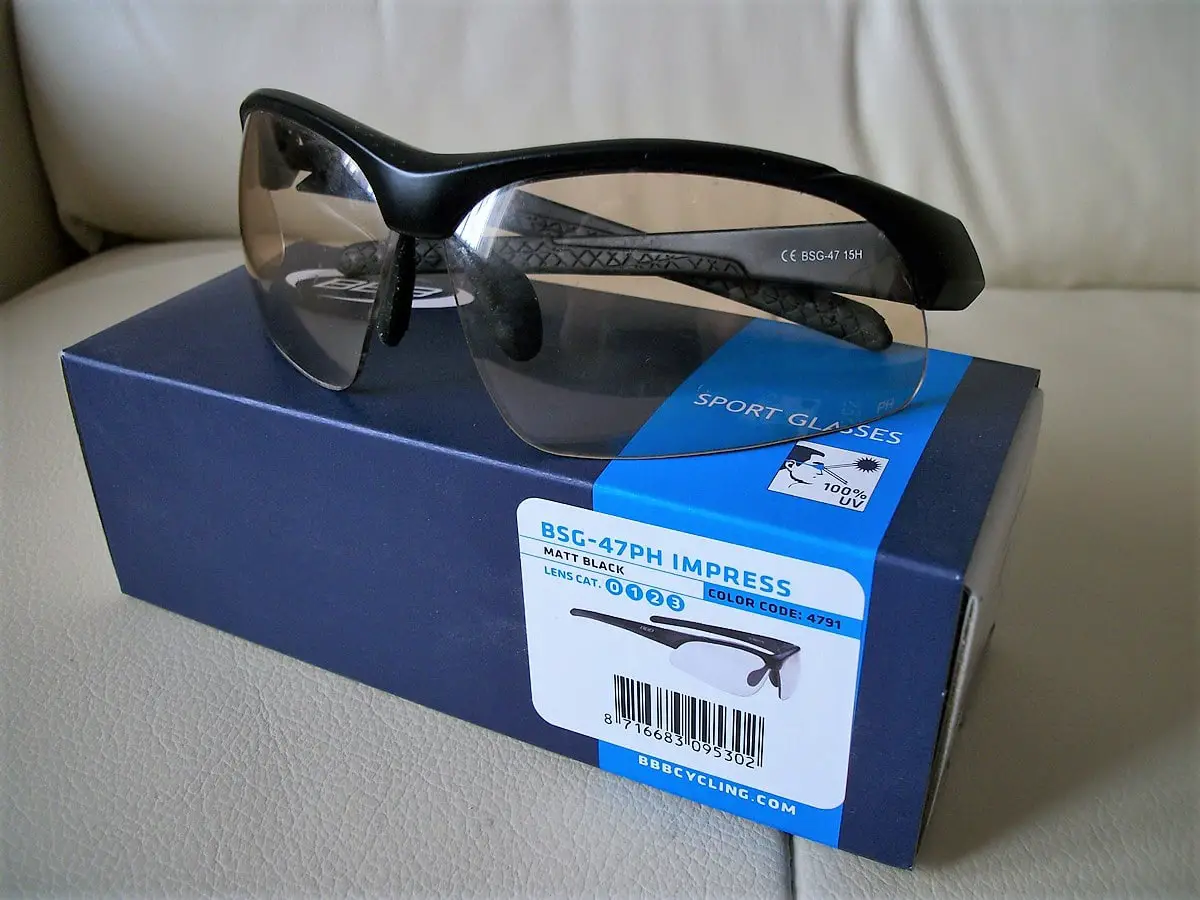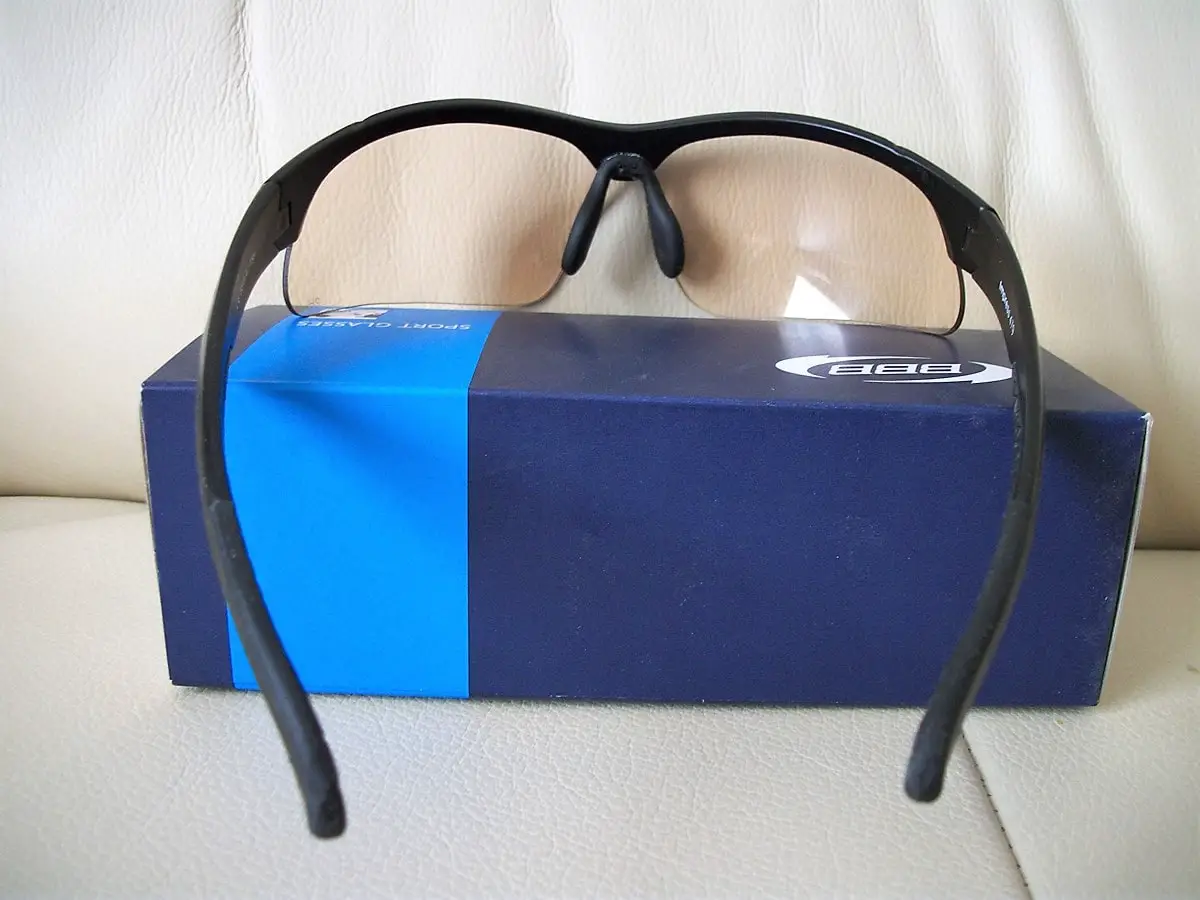Generally Cycling Glasses fall into two categories, they either come with a set of 3 or 4 lenses which can be switched out depending on the current lighting conditions or they have one Photochromic lens which adapts to the changing light conditions automatically. If you are in the market for a new pair of cycling glasses or you are looking to buy your first pair then I would recommend getting some Photochromic Cycling Glasses.
What are Photochromic Lenses?
Photochromic lenses darken when exposed to sunlight or U/V ultraviolet light and return to a clear state when indoors or if U/V light is reduced, such as at night. Most Photochromic lenses are made from plastic, glass or polycarbonate.
This ability for the lenses to transition in various light condition makes them ideal for cycling, particularly mountain biking, where you will be moving in and out of darker wooded areas back into lighter open areas.
How Do Photochromic Lenses Work?
Typically they have molecules of silver chloride and/or halide which is embedded within the lens. These molecules are invisible and therefore the lens is clear until exposed to sunlight/UV where a chemical reaction takes place.
During this reaction the molecules change shape, move and absorb the light causing the lens to darken. The lens will return to a clear state once moved indoors or away from sunlight/UV.
The time it takes for a lens to change from clear to dark and back again varies depending on brand/manufacturer. However, on average they will take between 8 and 30 seconds to darken and about the same again to return to a fully clear state.
What do the different lens categories mean?
When buying a pair of Photochromic glasses it’s worth finding out what category the lenses are. The categories can vary slightly between brands but they generally follow the European ISO standard. The category number equates to a percentage of VLT (Visible Light Transmission) – basically the amount of light the lens lets through.
Category 0: 81-100% VLT (clear or very light lenses)
Category 1: 50-80% VLT
Category 2: 25-43% VLT
Category 3: 9-18% VLT
Category 4: 0-8% VLT (very dark lenses)
It should also be noted that Photochromic lenses filter out 100% of harmful UVA and UVB rays so will protect your eyes as well as any other type of sunglasses.
What to look for when buying Photochromic Glasses
When looking to buy your first pair of Photochromic glasses I would recommend checking a few things before deciding on your purchase, see my checklist below:
- Fit & Comfort – some frames are designed for narrower heads, some for wider heads and some are a more universal fit. So ideally you want to try them on before you buy or if buying online make sure the retailer makes it easy to return them if they are’nt suitable for your head shape.
Also, preferably you want a pair that has an adjustable nose piece allowing you to mould it to the shape of your nose and so they won’t fall off when riding over rougher terrain - Lens VLT (Visible Light Transmission) Range – I would recommend looking for glasses with lenses that offer atleast Category 1-3 range and if you want to use them while night riding then look for Category 0-3
- Ventilation / Anti-Fog Treatment – this last point isn’t entirely necessary but it’s nice to have glasses that don’t steam up during more intensive exercise such as when riding up a steep climb. Some glasses reduce the amount of fogging by having a small slit or holes cut into the lens allowing cooler air to ventilate them. On more expensive glasses the lenses may have also been given an Anti-Fog treatment, although I believe the effectiveness of these treatments varies greatly
Which Photochromic Glasses do I recommend?
It used to be the case you had to spend over £100 to get a decent pair of Photochromic sunglasses. Fortunately in recent years the prices have come down alot and there are now several brands offering Photochromic cycling glasses for £50 or less.
After a lot of research I decided to try the BBB BSG-47 (now replaced with the BSG-58) which were on offer at the time for around £30. Apart from the bargain price, what really appealed to me were the lenses, with a Category range of 0-3 (85-17%).
This broad range of light transmission means they would be clear enough for darker/overcast light conditions, even night riding and dark enough for bright sunnier days in the summer.
I also thought they had a nice understated style to them with a good wrap-around lens shape. But perhaps, more importantly, they have a claimed transition speed of 8 seconds. Please see my review below for more details.
Long Term Review
I’ve now owned these glasses for over 2 years and have been very pleased with them, particularly when considering glasses with similar features can cost 3 or 4 times as much.
Fit & Comfort
I have quite a large head but find these glasses really comfortable to wear. They have a nice soft flexible nose-piece and so have never fallen off while riding over any terrain!. I would say they will fit most medium to large sized heads comfortably. Lenses wrap quite far around the edges of the eye providing good protection from bugs, rain and wind etc. I also think they look quite stylish with their understated, clean lines.
Lenses
As mentioned in my recommendation earlier the lenses have a Visible Light Transmission Range of 85-17% which I have found makes them dark enough for the british summer and clear enough for night riding. I have tried to show how clear the lenses go in the photos below.
I can’t say with 100% certainty that the claimed transition time of exactly 8 seconds is true. However, I’ve not found the transition speed to cause me any issues when moving from a darker woodland environment back into a lighter open area or vice versa. So in this regard I feel the lenses work very well and fulfill the main purpose of purchasing Photochromic glasses.
Ventilation
Although these glasses don’t have any ventilation holes or anti-fog treatment I find they don’t fog up too much during most rides. They can fog up during long climbs or during winter as the temperature difference between your warm face and cold lens becomes greater. However, if you just temporarily slide the glasses forward a few seconds then the fogging usually clears pretty quickly.
Build Quality/Durability
I have used these glasses for both Mountain Biking and Road Cycling and generally they are still in good condition with no parts becoming loose or broken. Obviously after this much use there are some scratches on the lenses but these have not effected their performance.
Conclusion
Due to their reasonable price, good fit, effective Photochromic lenses and solid build quality, I would Highly Recommend the BBB BSG-47PH Photochromic Cycling Glasses. Unfortunately, this particular model is no longer available. However, the latest 2019 version of these are now available from Amazon – click here to check current pricing
Other Options
Alternatively, if the reviewed model becomes unavailable they do a slightly more expensive model with vented lenses – click here to check current pricing
Another option worth considering are the FWE Rayet Glasses by Evans Cycles which are currently just £44.99
Also consider the DHB Omnicron sold by Wiggle Cycles. DHB is Wiggle’s in-house brand and generally considered to be good quality.
Other Recommended Cycling Gear
Brand-X Ascend – Best Budget Dropper Post
How to clean your Bike chain without removing it
Best All-Round Mountain Bike Tyre
Essential Gear for a Mountain Bike Beginner

